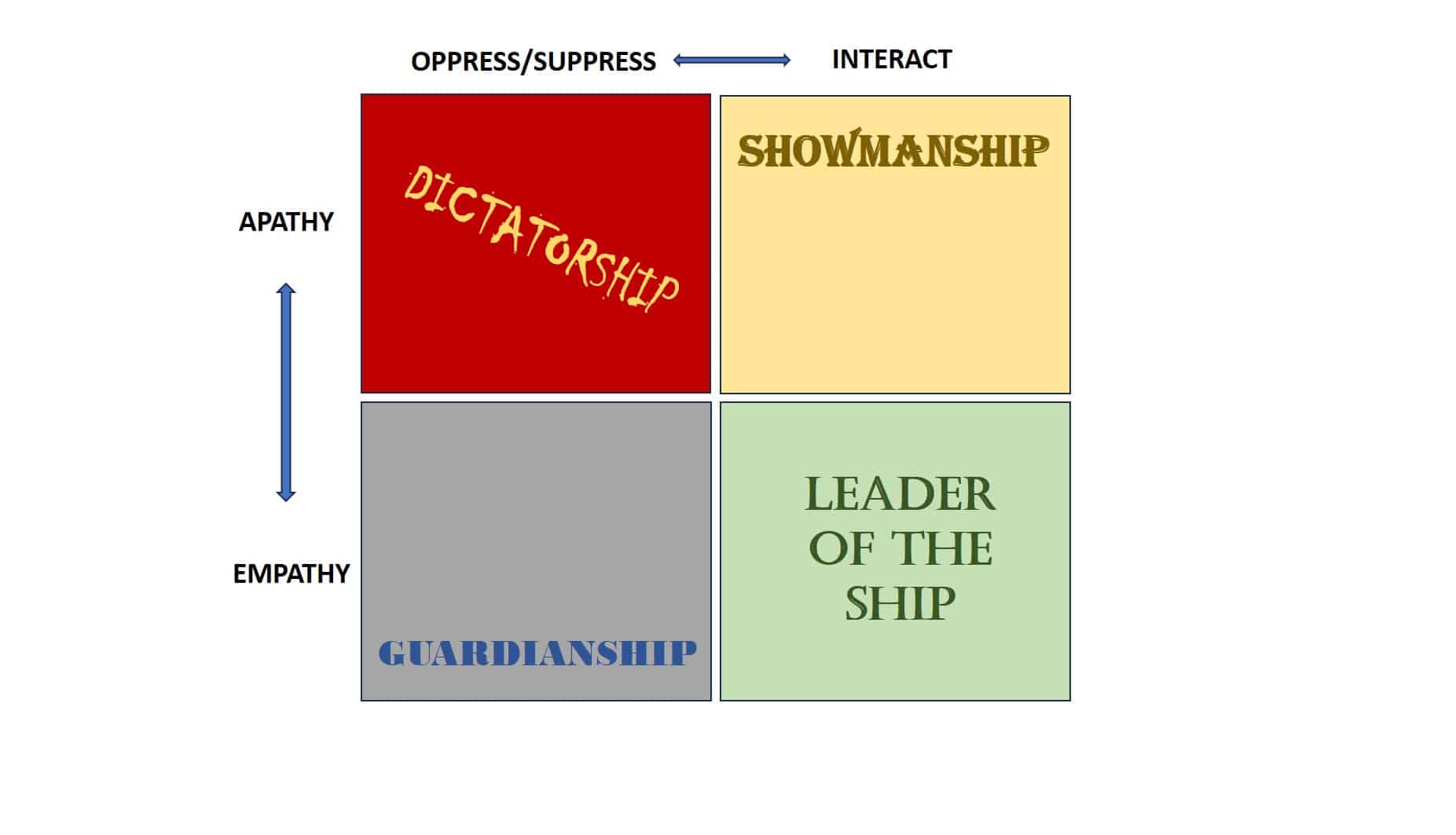
What’s your predominant style as a leader—and why does it matter?
There’s plenty for everyone to cheer and grouse about in the headlines around the 47th Chief Executive of the USA, thus far. Early returns on the people, organizations, assets and outcomes in 47’s predominant leadership style are already in, with a mixed scorecard.
Set aside technical skills for the moment and think of the ways leaders can encourage or suppress teams—in other words, how the attitude and style of a leader can leverage and empower people, or erode their contributions and enthusiasm. Style, as a leader can catalyze, unlock and multiply their peoples’ thinking, convictions and perceptions—all to the organization’s benefit, or not. Let’s use empowerment and empathy as X/Y-axis criteria and define four distinctive leadership styles: Showmanship, Guardianship, Dictatorship and Leader-of-the-Ship. Then we can unpack the implications of these styles.
Who are you? That snipped question aims at the heart of an American truism rampant today: The unexamined life—especially if it cuts close to you. As a leader, you are constantly operating in one of the four styles above. How did you come to your leadership style in the moment?
Leadership is either the exploitation of style to benefit the Mission and your people pursuing that Mission, or leadership itself becomes hostage to reactionary tendencies that take over in the urgencies and pressures of leaders and their teams, whether it’s in a factory or the Oval Office. A leadership style employed by default versus intent is akin to amateur heart surgery. Exciting, but rarely with a good outcome.
It may surprise you to hear it is often necessary for a leader to employ any of the four styles across the moments of an organization, but only if it is done with intention. Each of the styles have pros and cons, and the consequences are not trivial to organizational success, so choose well and wisely.
Showmanship is about drawing attention to issues by reaching people the leader does not control. Think of the showman in a good sense as serving PR and Marketing, aimed at the Mission. Every leader needs a bit of the intentional showman to promote, rally and build conviction and consensus in customers, voters and investors.
But in its darker form, Showmanship is driven by egotistic lust, the desire for glory, and it’s all about personal recognition. If Showmanship is predominant over Mission, the first casualty becomes the Mission, followed by demoralized people and organizational chaos. Ultimately, at its darkest core, Showmanship is “all about me”. The self-centered showman snatches the glory and credit in success, and derides the lesser people in any downsides. The showman wants to be seen as calling all the shots, given credit for all the announcements and decisions. People become commodities, expendables for the exploitation of a showman. If that commodity adds to the showman’s glory, keep them around. If not, ditch them. When a showman’s key people come to realize that today’s pat on the back can become tomorrow’s dagger, why would they stick around? Why even try? Nobody is ever really “in” with a showman.
In 47’s Administration we have examples of each of the four leadership styles, yet the “Showman” seems to keep popping up. Daily. Examples like the treatment of Ukraine’s President in February. Or the bromance with the worst of global autocrats. There’s that tendency to be ‘the one’ who takes credit for all the announcements and pronouncements. In true showman form, there’s plenty of castigating when the showman lacks the power to terminate those out of favor and out of his reach, like Fed President Jerome Powell or the numerous Federal judges being carped on. And, there’s no missing the showman’s aggrandizing and puffery on X/Twitter. “Me! My! Mine!” These are just symptoms of Showmanship writ large.
Guardianship avoids risks, wants things smooth and quiet. Intentionally engaged Guardianship has upsides. There are a lot of things we need to run quiet, steady and low-risk, like our transportation systems, banking systems and healthcare. In commercial organizations I want CFO’s who have strong guardian skills. In the operating room, give me a guardian surgeon. Guardian traits are absolutely necessary for flourishing societies and organizations.
There are darker forms of Guardianship as well. Without disciplined use, a reflexive guardian will struggle to aim at the Mission precisely because the default of a reflexive guardian is to sustain credibility.
In default, guardians don’t actually lead. They maintain. Keeping things on the down-low, de-escalated, demurred, deferred. Silence first, or slow and incremental change, if required, are their go-to plays. What a defaulted guardian dreads most is embarrassments and anyone who can terminate them (Boards, Voters, Superiors). Similarly, those who can put a spotlight on a guardian to make them appear weak or not in charge (Journalists, Stockholders, Headlines) are dreaded—or avoided. An obsessive guardian wants all the machinery, politics and people rigged to run silent, especially when things aren’t going well.
Guardians can be loyal to their people (as long as the people don’t embarrass the guardian). Guardianship will virtue signal honesty, civility and decorum as a means to sustain credibility—although the virtue may not in fact be virtuous, and the signal may actually just be noise.
The 46th Administration (Biden) offers numerous defacto Guardianship examples—from impotent foreign policy like “sanction Putin if he invades Ukraine” to the Afghanistan exit debacle to failed CPR on the Iranian Nuclear Agreement. Even the drama to cling to a run for a second Presidential term illustrate guardian choices to sustain, avoid, blame and survive.
Guardianship’s influence will infest the organization’s people and ethos with the same reflexive weaknesses. A guardian’s obsessions transmorph an organization’s mission into guarding a guardian’s fiefdom, at the cost of the real Mission. Guardianship untethered is a certain path to organizational mediocrity, second-rate recruiting and long-term entropy.
Dictatorship as a style is often rejected out of hand, as immoral and evil. That’s an overstretch. You and I actually need some dictators, just not the pathological variety. For example, I WANT a doctor to dictate my treatments in complex medical circumstances. We need someone in an organization to break us out of circular reasoning and gridlock, and call the decision. Think of World War 2’s D-Day launch decision—where General Eisenhower had to be a dictator to break through the significantly divided and paralyzed senior team to get the Mission back on track. Similarly, when a business needs a turnaround, the go-to style that a traumatized team will most respond to is a dictatorial “Go do this.”
But an unrestrained Dictatorship rejects critical thinking, sets objectives by whims and emotions, and declares an enemy of anyone pushing back or scrimmaging alternate ideas. Some negative dictatorial styles are simply fearful people using power. Most though, are brazen bullies. Interestingly, dictators, like bullies, tend to flee encounters against strength.
Instinctively, dictators wobble in their convictions—lunging into how they feel in the moment. They do not do well with a Mission, with focus, with stability, with developing people, nor in wisely employing assets. Mission under a Dictatorship becomes whimsical—spur of the moment twists and turns, retreats and lunges. The team lives in perpetual uncertainty. Uncertain teams make for disasters.
47 defaults almost as often to a dictatorial style as he does to the showman. The boss’s demeanor and opinions are rigidly fixed. Until he isn’t. His opinions are sacrosanct, absolute and unchallengeable, until tomorrow, when he heads off in yet another direction. For his team, it’s conform in the moment, or you are disloyal and out. Using a bully pulpit to demean dissenters, firing those who disagree, snatching authority out from under the team—all these behaviors emerge from an unconstrained dictatorial penchant.
Think of 47’s recent firings of BLS’s Erika McEntarfer, and the IRS’s Billy Long; think of the dumping of so many highly qualified key people from his own (45th) Administration—Bolton, Pompeo, Tillerson, McMaster—to name just a few.
Consider 47’s dictatorial vacillations in US foreign and domestic policy, careening from week to week over who is really the bad guy between Ukraine and Russia, over petro-sanctions or intelligence blackouts. There are fantasies and recants about what 47 will accomplish, what sanctions and action 47 will take. Then we get the retreats “I was joking about solving Ukraine in 24 hours” and musings around whether Putin, somehow, may not really be sincere about peace.
Dictatorships promise big, then declare victory no matter what. Again with 47, think of the campaign pledges toward reducing the US deficit, reversed into the “live with it” impacts of tariffs…on, off, deferred, waived, reinstalled. Is China really a threat, or is Taiwan just a “sharpie” to be tossed? (Trump’s metaphor). Flip-flopping is classic pusillanimous Dictatorship.
I’ve worked with and counseled family-owned businesses, where the family’s head was more dictator than leader. Every week was a new vector, a new direction or a new program—and sadly, a new blacklist of people who were loyal and valued employees just days before. The results are teams stifled, while the latest zig-zag by the boss is the only thing that ever mattered.
Leader-of-the-Ship is the rarer form. There can be times when this style is inappropriate—for example, in a time compressed opportunity or crisis. Predominantly, Leader-of-the-Ship is where you want your leadership style to reside, to focus on Mission, to hone skills and to coach succession in leading that ship.
47 has some impressive examples of “Leader-of-the-Ship” teamwork in 2025:
- Inducing the EU to say it will detox from its US-financed defense hangover
- Securing US borders
- Eroding Iranian nuclear weapons ambitions—many thanks to Israel for paving the way
- Reducing government largesse—both headcounts and ineffective/renegade shops
- Confronting China’s cold-war revanchism
- Revitalizing interests in US defense and strategic manufacturing
We’ve also covered a few examples of the darker side of 47’s styles:
- US economic uncertainty with on-again-off-again tariff threats
- Slandering Canada and Mexico as commercial adversaries
- Bromance with Putin – making Russia the victim and Ukraine the perp
- Predictability: Demand the outrageous, settle for much less
- Threaten loudly, then run away from confrontations with Russia & China
So, who are you?
Do you understand the real Mission that defines your personal purpose and the style(s) you employ? Is Mission the way you animate interactive and empathetic conversations with people – especially your team, your customers and investors? Do you understand what your people are saying, even when it contradicts your own gut? Do you know when to switch styles to serve the Mission?
Clarity of Mission, drawing out ideas, conflicts and driving consensus, delegating authority, coaching, mentoring—all these are symptoms of effective leadership.
To say it another way, your role as a leader is to give meaning, purpose, identity and belonging to your people—aimed at the Mission.
Do you understand your ‘Why’—your organization’s Mission? Are you developing people, policies and processes to employ assets toward that Why? Are you listening? Understanding? Developing others? At times, any of the four styles may be needed. At times, even the “Leader-of-the-Ship” style might be the wrong play. But you have to start with your you. Do you know who you are?
Are the temptations and whims of reactive leadership wrecking your Mission? Focus on your Why. That kind of leadership will make your organization, and America greater, again.
Dennis is a six-time Chief Executive Officer specializing in “turnarounds” for Wall Street backed corporations. More on Dennis on LinkedIn and at www.thediscipledilemma.com
